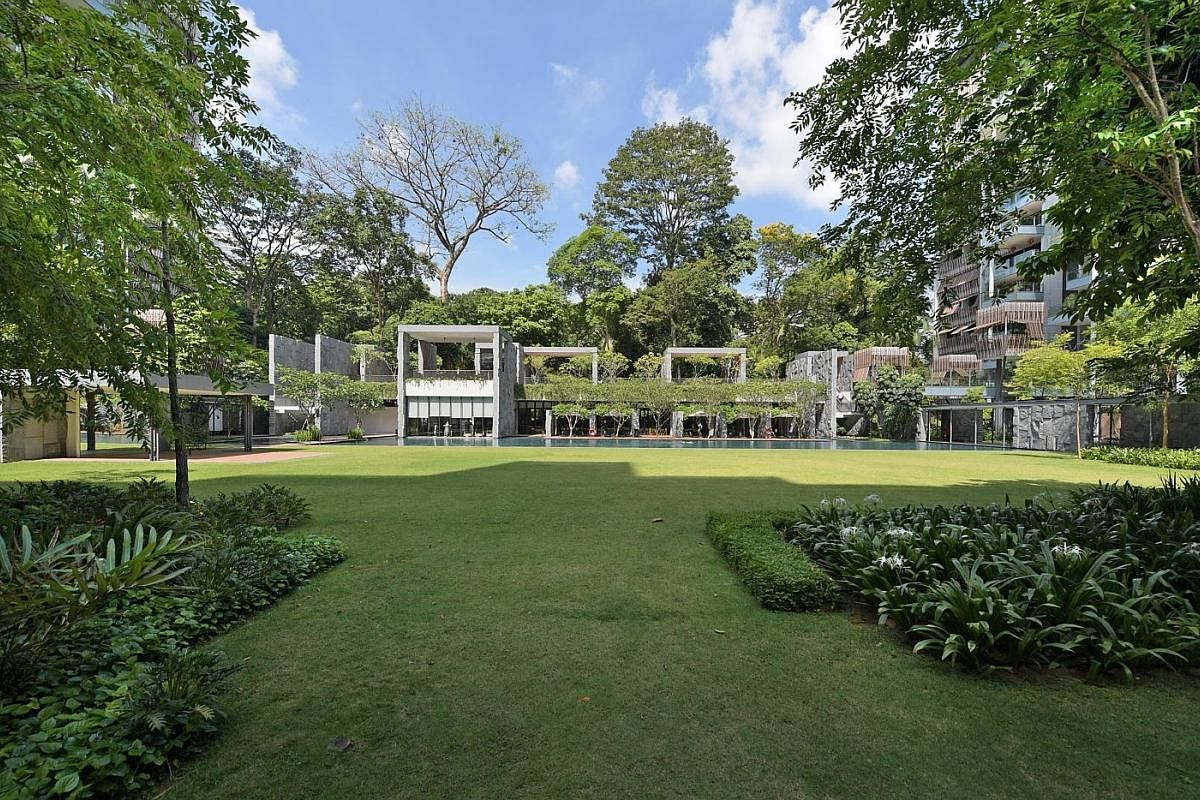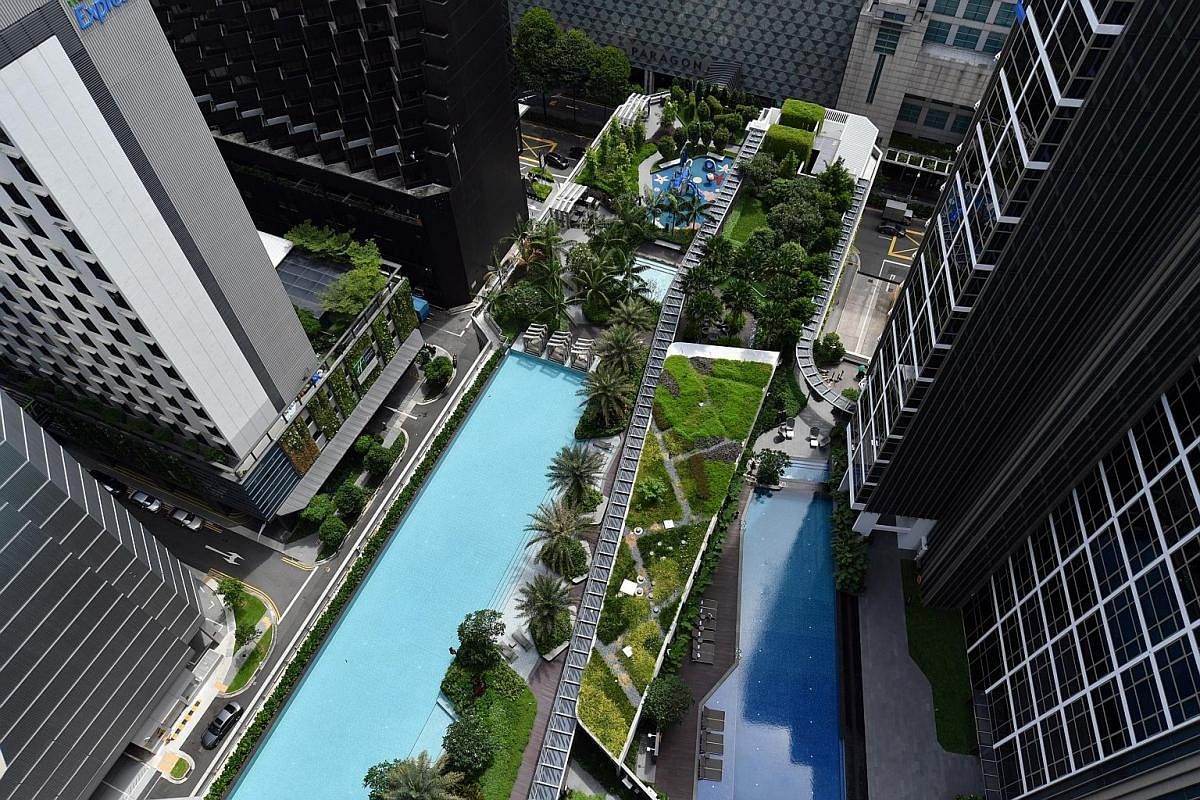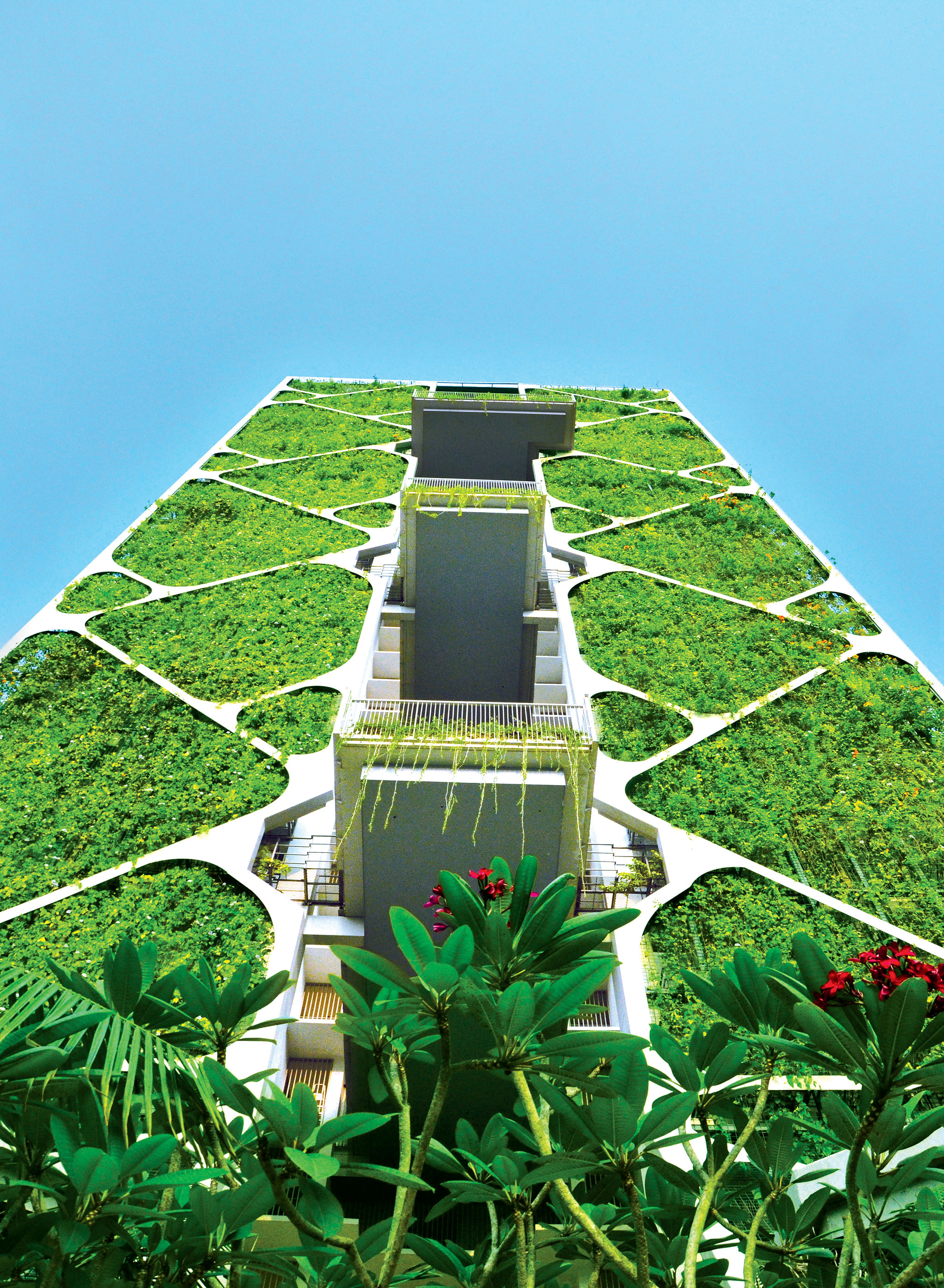Condos go back to nature
More condominiums are adding extensive greenery to differentiate their properties from others




A botanical garden with 200 species of plants, a 200m-long forest trail and a hanging garden with about 32,000 potted plants are some of the green features found at several new condominiums here.
An increasing number of developers are devoting an extensive part of their private residential projects to plants and coming up with novel ideas to green them up.
Three recent condo projects by City Developments Limited (CDL) are a case in point.
The Rainforest in Choa Chu Kang, completed in 2015, was conceptualised as a "nature reserve" for threatened plant species. It has 22 native species of trees and palms and 26 native species of shrubs and groundcover.
Meanwhile, the Tree House condominium at Chestnut Avenue in Bukit Panjang has a 24-storey green facade, which entered the Guinness World Record for largest vertical garden in 2014; and the Lush Acres executive condominium along Fernvale Close in Sengkang has a hydroponic farm, where residents can grow their own herbs and vegetables within a temperature-controlled environment.
In another example, three luxury condominium developments, including Goodwood Residence in Bukit Timah Road and Leedon Residence off Farrer Road by another developer, GuocoLand Singapore, have set aside more than half of their land to greenery.

GuocoLand Singapore's newest luxury condominium project, Martin Modern in River Valley, which is expected to be launched in the second half of this year, will dedicate over80 per cent of its land area to a botanic garden with about 200 plant species, many of which are native to this region.
GuocoLand Singapore's group managing director Cheng Hsing Yao says that in highly dense and land-scarce Singapore, a sense of space and greenery has become a luxury.
He says: "We want to offer this something extra to our residents in our developments, whenever the terrain allows and the site is large enough."
Mr Nicholas Mak, head of research and consultancy at SLP International Property Consultants, adds that with so many condominium launches - there were 268 launches over the last five years - it is increasingly challenging for developers to come up with themes to differentiate their properties from others in the market.
So, while some try to add a concierge service or have a wellness aspect, others put in novel green features.
A CDL spokesman adds: "Beyond enhancing a development's aesthetic appeal, greenery also creates a better environment by reducing heat, improving air quality and filtering carbon dioxide."
Meanwhile, other developers say that greenery adds value not just for their residents but also the public.
For instance, CapitaLand has a 410m-long green wall adorned with close to 32,000 pots of plants around an integrated development in Orchard Road, which includes Cairnhill Nine, a 30-storey condominium which is one of the tallest buildings in the area.
"The green wall enhances the design of the development for shoppers, pedestrians and drivers passing by," says CapitaLand's vice-president of development and design Eng Tiang Wah.
It helps that many of these green condominiums sell well.
For instance, all 210 units at Goodwood Residence which launched in 2010 have been sold, while 90 per cent of the 381 units at Leedon Residence have been sold since it was completed in 2015.
Sales have also been swift at other green projects including Lush Acres and The Rainforest, which are sold out, and Cairnhill Nine, which is 90 per cent sold.
But would adding more greenery eat into the space for other facilities?
To get around this, CapitaLand aims to "seamlessly integrate greenery into the design", says Mr Eng.
For instance, the roof covering the function room, wine lounge, spa rooms and reading room at Cairnhill Nine is greened up, so residents looking out of their balconies will not see brick-and-mortar.
ICN Design International, the landscape architect behind the Martin Modern project, designed the condominium such that all 450 units are housed in two 30-storey towers. This helps minimise building footprint, so that more space can be devoted to greenery, says ICN director Simon Morrison.
At Goodwood Residence, utilities and services such as a basement carpark are located within the building, to reduce its impact on the project's footprint.
Maintaining such extensive greenery, however, requires effort and money.
At Leedon Residence, five full-time gardeners tend to the green spaces, which take up more than half of its total land area of 48,000 sq m and include a 200m-long forest trail. The gardeners carry out daily tasks such as weeding, trimming and loosening plant beds.
Occasionally, they also have to wade into the reflective pool, which has eight palm trees inside, to pick up fallen fronds or remove flowers. Another team of gardeners comes in about once a week to perform more major works such as pruning.
To make maintenance easier, most of the plants chosen are natives such as yellow flame and tembusu which are hardy and drought-resistant, says Ms Wahyuni Kurniawati from SCDA Landscape, the landscape architect for Leedon Residence.
The cost is typically passed down to residents, who pay a higher conservancy/maintenance fee. According to industry sources, the maintenance fee of each unit of such green luxury developments can hit $800 or more a month. Such fees typically hover around $300 a month for projects that are less green.
Ultimately, whether these green concepts can continue as envisioned depends on whether residents want to spend the money, says property consultant Mr Mak.
He says: "After the property is completed and the management handed over to residents, and they realise the cost of such a service, then a cost-conscious committee might vote to stop it."
For now, however, Leedon residents such as stay-at-home mum Janet Lin, who is in her 40s, feel that the extra cost is worth it.
Ms Lin, who moved into the condominium with her husband and two children aged 14 and 16, in 2013, says her family loves the green features so much that they have been spending more time outdoors.
Her favourite green area is the forest trail, which comes with a mini-pavilion for resting as well as an outdoor fitness area.
She says: "You cannot see any high-rise buildings and you feel like you are inside a real forest."

Lush green properties
CAIRNHILL NINE
Where: 9 Cairnhill Road
What: This condominium, comprising a 30-storey 268-unit private residence, is part of an integrated development by CapitaLand which also includes a 20-storey, 220-unit serviced residence called Ascott Orchard Singapore.
The condominium, which is on a 99-year lease, was completed last year and the landscape architect is Coen Design International.
Green feature: A 410m-long green wall encloses the entire development and comes adorned with 31,570 potted plants, each fitted with automated irrigation and fertigation (injection of liquid fertilisers into the irrigation system).
This allows the plants to be safely maintained from within the building.
About 90 per cent of the units are sold. Unit price for available units starts at $2.6million.
GOODWOOD RESIDENCE
Where: 261 Bukit Timah Road
What: A freehold luxury condominium comprising two L-shaped 12-storey blocks of a total of 210 units. Launched in 2010, it spreads over a land area of 24,844 sq m, with about 80 per cent of it being greenery. It is developed by GuocoLand Singapore and its landscape is designed by ICN Design International.

Green feature: A large central lawn, about the size of 11/2 tennis courts, forms the focal point of the whole development. All apartments in the two L-shaped blocks have a breathtaking view of the lawn, a swimming pool in the foreground and a green forest of towering native trees "borrowed" from the nearby Goodwood Hill, as a backdrop.
The units are sold out.
THE RAINFOREST
Where: 331, Choa Chu Kang Avenue 3
What: A 466-unit luxury executive condominium with eight apartment blocks, from three to 21 storeys, this 99-year leasehold project by City Developments Limited spreads over lush verdant grounds totalling close to 17,600 sq m. It was completed in 2015 and the landscape was designed by home-grown architecture and design firm Ong & Ong.
Green feature: The development was replanted entirely with native trees and plant species to recreate a "rainforest" landscape setting. The plants were carefully selected to ensure that they attract and sustain wildlife such as butterflies and birds originally from the nearby wooded area.
The units are sold out.
ECO
Where: 201 to 283 Bedok South Avenue 3
What: A joint venture project by Far East Organisation, Frasers Centrepoint Limited and Sekisui House, this 99-year leasehold development over an area of more than 28,600 sq m was launched in 2012. It comprises 714 units housed in eight blocks of 12, 15 and 16 storeys and 34 units are in three-storeyed strata terraces . Its landscape architect is ICN Design International.
Green feature: A 100m-long boardwalk, which is elevated from between 1m and 5.5m, is built along a landscape of conservation trees lining the eastern border of the development. At the end of the trail, there is a "rain garden" which collects, filters and stores rain water runoff to be reused to irrigate the development's landscape. There is also a community plot for residents to grow and plant vegetables and herbs.
The units are sold out.
Join ST's Telegram channel and get the latest breaking news delivered to you.
A version of this article appeared in the print edition of The Straits Times on May 13, 2017, with the headline Condos go back to nature. Subscribe
